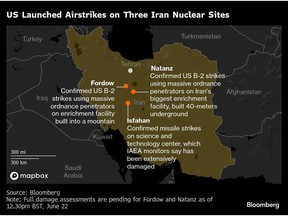
Article content
(Bloomberg) — President Donald Trump’s decision to order US forces to attack three key Iranian nuclear installations may have sabotaged the Islamic Republic’s known atomic capabilities, but it’s also created a monumental new challenge to work out what’s left and where.
THIS CONTENT IS RESERVED FOR SUBSCRIBERS ONLY
Subscribe now to read the latest news in your city and across Canada.
- Exclusive articles from Barbara Shecter, Joe O'Connor, Gabriel Friedman, and others.
- Daily content from Financial Times, the world's leading global business publication.
- Unlimited online access to read articles from Financial Post, National Post and 15 news sites across Canada with one account.
- National Post ePaper, an electronic replica of the print edition to view on any device, share and comment on.
- Daily puzzles, including the New York Times Crossword.
SUBSCRIBE TO UNLOCK MORE ARTICLES
Subscribe now to read the latest news in your city and across Canada.
- Exclusive articles from Barbara Shecter, Joe O'Connor, Gabriel Friedman and others.
- Daily content from Financial Times, the world's leading global business publication.
- Unlimited online access to read articles from Financial Post, National Post and 15 news sites across Canada with one account.
- National Post ePaper, an electronic replica of the print edition to view on any device, share and comment on.
- Daily puzzles, including the New York Times Crossword.
REGISTER / SIGN IN TO UNLOCK MORE ARTICLES
Create an account or sign in to continue with your reading experience.
- Access articles from across Canada with one account.
- Share your thoughts and join the conversation in the comments.
- Enjoy additional articles per month.
- Get email updates from your favourite authors.
THIS ARTICLE IS FREE TO READ REGISTER TO UNLOCK.
Create an account or sign in to continue with your reading experience.
- Access articles from across Canada with one account
- Share your thoughts and join the conversation in the comments
- Enjoy additional articles per month
- Get email updates from your favourite authors
Sign In or Create an Account
or
Article content
Trump said heavily fortified sites were “totally obliterated” late Saturday, but independent analysis has yet to verify that claim. Rather than yielding a quick win, the strikes have complicated the task of tracking uranium and ensuring Iran doesn’t build a weapon, according to three people who follow the country’s nuclear program.
Article content
Article content
Article content
International Atomic Energy Agency monitors remain in Iran and were inspecting more than one site a day before Israel started the bombing campaign on June 13. They are still trying to assess the extent of damage, and while military action might be able to destroy Iran’s declared facilities, it also provides an incentive for Iran to take its program underground.
Article content
By signing up you consent to receive the above newsletter from Postmedia Network Inc.
Article content
Indeed, there’s just a slim possibility that the US entering the war will convince Iran to increase IAEA cooperation, said Darya Dolzikova, a senior research fellow at the Royal United Services Institute, a London-based think tank.
Article content
“The more likely scenario is that they convince Iran that cooperation and transparency don’t work and that building deeper facilities and ones not declared openly is more sensible to avoid similar targeting in future,” she said.
Article content
IAEA inspectors haven’t been able to verify the location of the Persian Gulf country’s stockpile of near-bomb-grade uranium for more than a week. Iranian officials acknowledged breaking IAEA seals and moving it to an undisclosed location.
Article content
The IAEA called on a cessation of hostilities in order to address the situation. Its 35-nation board will convene on Monday in Vienna, Director General Rafael Mariano Grossi said.
Article content
Article content
Trump dispatched B-2 stealth jets laden with Massive Ordnance Penetrators, known as GBU-57 bombs, to attempt to destroy Iran’s underground uranium-enrichment sites in Natanz and Fordow.
Article content
Satellite images taken on Sunday of Fordow and distributed by Maxar Technologies show new craters, possible collapsed tunnel entrances and holes on top of a mountain ridge.
Article content
No evidence of damage to the underground enrichment halls can be seen, and IAEA inspectors reported there were no radiation releases from the site. US Air Force General Dan Caine told a news conference on Sunday that an assessment of “final battle damage will take some time.”
Article content
Before the US intervention, images showed Israeli forces alone had met with limited success four days after the bombing began. Damage to the central facility in Natanz, located 300 kilometers (186 miles) south of Tehran, was primarily limited to electricity switch yards and transformers.
Article content
The US also joined in attacking the Isfahan Nuclear Technology and Research Center, located 450 kilometers south of Tehran. That was after the IAEA re-assessed the level of damage Israel had dealt to facility. Based on satellite images and communications with Iranian counterparts Isfahan appeared “extensively damaged,” the agency wrote late on Saturday.

.jpg) 4 hours ago
1
4 hours ago
1
 English (US)
English (US)